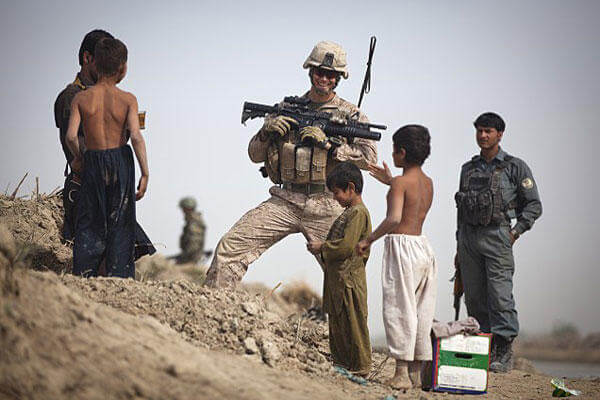It’s the timeless question that pervades the thoughts of troops caught up in a war winding-down -- Korea, Vietnam, Iraq and now Afghanistan: “What’s our mission?”
The answers from the top tend to vary, if answers come at all. The generals can also be at a loss. At the start of the Iraq invasion in 2003, then-Maj. Gen. David Petraeus, commander of the 101st Airborne Division, said: “Tell me how this ends?”
In the void, the troops search for their own answers. Their struggle to find meaning in what they are left to do in the 11-year-old war in Afghanistan played out in the pages of the Washington Post this week in the differing views of two Army platoons operating in the same area about 65 miles south of Kabul.
In an anguished response to the front-page Post article “A U.S. platoon awaits the end of Afghan war,” 1st Lt. Adam Swartzbaugh, writing from Jaghatu, Afghanistan, said “there is still a fight here.” “We live and breathe it” even as the U.S. and the allies shut down hundreds of outposts under the plan to have all combat forces out of Afghanistan by December 2014.
“Whether we are winning a war is irrelevant in my platoon,” Swartzbaugh said in his letter to the editor that was posted in the newspaper’s full-page “Free For All” section on Saturday.
“What do my men and I consider a successful mission? It is when we have done something, anything, to further protect the lives of our soldiers, period,” Swartzbaugh said. “In so far as we are able to do this, my men will continue pushing themselves further and deeper in every dimension of the physical, psychological and spiritual -- to the very limits of war, and to the end of life. “
The Oct. 12 Post article that Swartzbaugh took issue with also carried the Jaghatu dateline. It began with a platoon sergeant asking the question of the 3rd platoon: “What do you consider success on a mission?”
“Sgt. Gary M. Waugh, a soldier on his second Afghan tour, takes a stab at answering the question. ‘Us not doing a thing,” the soldier says in the article. “Not firing our weapon.’
Swartzbaugh complained that the Post article described “Antennae Hill,” a key terrain feature in the area, as a pacified place that had seen its last firefight in May.
Swartzbaugh wrote: “On the piece of terrain called Antennae Hill noted in the article, my platoon just this month was engaged in a daylong firefight with an estimated 40 Taliban insurgents. We dodged rockets and fire from automatic weapons, returning in kind with everything from sniper rifles and machine guns to Javelin missiles and A-10 gunships.”
From a distance, it’s easy to say that both the Post article and Swartzbaugh are probably right. The troops in Afghanistan, the troops in any war, live at the intersection of all-consuming boredom and adrenaline-pumping combat. Two platoons from the same battalion can have entirely different outlooks on what’s happening on the ground and what their mission is, or should be.
In Vietnam, there was a running joke among some Marine lieutenants going back to the Five Paragraph Order, as it was then called, that was learned at The Basic School in Quantico, Va. It was “SMEAC,” pronounced “Smee-ack,” for Situation, Mission, Execution, Administration and Logistics, Command and Control.
The joke was that the brass lost the second paragraph back in the states. What was left was doing what you were told to do and trying to leave the big picture, if there was one, to others.
Swartzbaugh appeared to have a similar viewpoint in the ending of his heartfelt letter.
“The sweat and blood of men who believe in what we are doing will continue to run through these mountains and into this sand, until every last one of them has returned home,” he wrote.
“We are not awaiting an end -- only for the sun to set so we can push, into the darkness, onward to the next objective.”
-- Richard Sisk served as a lieutenant with the 2nd Battalion Fourth Marines in 1967-68.





























